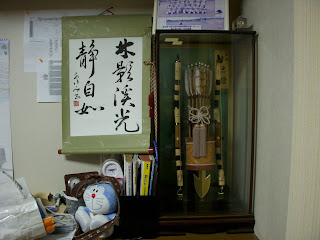Now the tree next to it is changing to red, how beautiful.


photo from Shizuoka, where is hometown of one of my friends.
This fall, I've visited there. Mt.Fuji is often used to represent Japan.




a lot of 芸人 are going to perform. The picture above is one scene of 吉本新喜劇(new comedy of Yoshimoto?) When I was little, my grandparents took me to the play. I don't remember the content, but the performers were so funny that I laughed a lot. In the photo, the middle man in black suit is 池乃めだか(Ikeno Medaka.) He is one of the most popular comedians. His height is very very short for men, but it gets him special.
The picture above is one scene of 吉本新喜劇(new comedy of Yoshimoto?) When I was little, my grandparents took me to the play. I don't remember the content, but the performers were so funny that I laughed a lot. In the photo, the middle man in black suit is 池乃めだか(Ikeno Medaka.) He is one of the most popular comedians. His height is very very short for men, but it gets him special.
 This photo is very very old because the man in the upper left-hand poster has been arrested for fraud(maybe?) a few years ago.
This photo is very very old because the man in the upper left-hand poster has been arrested for fraud(maybe?) a few years ago. ↑This is my neighbor's house. The son, who is same age as me, used to tell me that his family is supporting 自民党(the Liberal Democratic Party). They have always such posters on their house's wall. As you see, it is Aso-san now. Some years ago, it was Koizumi-san. People supporting a party get posters from an office of the party. Then, they are willing to put them on their house and show their will to support the person.
↑This is my neighbor's house. The son, who is same age as me, used to tell me that his family is supporting 自民党(the Liberal Democratic Party). They have always such posters on their house's wall. As you see, it is Aso-san now. Some years ago, it was Koizumi-san. People supporting a party get posters from an office of the party. Then, they are willing to put them on their house and show their will to support the person. the Tenrikyo headquarter
the Tenrikyo headquarter
 "ようこそおかえり" means "welcome home." You can see a lot of signs saying that in Tenri-city. They think the city is home of all believer in Tenrikyo. There were really many signs like the photo, so I felt a little weird.
"ようこそおかえり" means "welcome home." You can see a lot of signs saying that in Tenri-city. They think the city is home of all believer in Tenrikyo. There were really many signs like the photo, so I felt a little weird.
Tenrikyo has homepages in a lot of languages:http://www.tenrikyo.or.jp/index.html
 randoseru with my cousin.
randoseru with my cousin. black one
black one randoseru in classroom from Wikipedia
randoseru in classroom from Wikipedia
However, new elementary school students can choose the color of their randoseru in these days. We will see a lot of students having colorful randoserus on their back.
many colors:http://item.rakuten.co.jp/kagunavi/gd-00110/
Sadly, naginata is not a so popular sport. There were only a few schools which have the clubs in my home city. I have a little sad memory in my mind. When I entered high school, a new friend asked me if I had been on any clubs in my middle school, if so, what club it was.
"Yes, naginata club." I answered.
"Naginata...? kind of card game??" she said.
"What..??? card game..?????? Is she sure?"
After that, I explained one of sport "naginata" to her. This made me aware that naginata is much less popular than I had thought. Even Japanese, some of them don't know this sport.
further information about naginata : http://naginata.jp/eng/eng1.html
 My junior in the club is having a match.
My junior in the club is having a match. after-school practicing
after-school practicing


This site has funny signs in English and some of them are taken in Japan. http://www.engrish.com/

The second photo is a catalogue of "Furisode" for Coming-of-age Day. Coming-of-age Day(Seijin no hi) is the second Monday of January. We celebrate this day to welcome young people who are 20 or going to be 20 in that year as new members of society. This year, my sister has this ceremony. For that day, she had had her own kimono made almost one year in advance. Lately, it has arrived and she got excited so much.
 I'm wondering why their models are not Japanese. Though most of customers are supposed to be Japanese people.
I'm wondering why their models are not Japanese. Though most of customers are supposed to be Japanese people. The topic is Japanese people.
The topic is Japanese people.The man sitting in front of TV is my father. He is working for a construction company. After he came back to home and took a bath, he drinks a can of beer. That is one of his pleasure.
My mother is a houseworker. She is into Korean dramas now like other middle-aged women.
My family has four children, and I am the oldest girl. My younger sisters really like watching foreign movies. They often go to TSUTAYA together and rent some DVDs.

This is my brother. He looks relaxed and seems to be falling into a sleep on the massaging chair.
By the way, the TV show we were watching this evening was interesting. The show is "笑ってコラえて". You can watch it on Channel 10 from 8 p.m. on every Wednesday. I am sure it shows real Japanese people.



from: http://www.itmedia.co.jp/news/articles/0806/02/news073.html#l_yuo_manto_02.jpg

